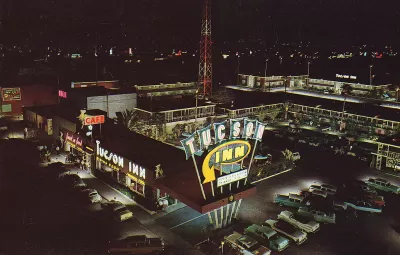After tremendous success with a streetcar line, the desert city is considering strategies for investing in its historic automobile corridor.

Four years ago, the Sunlink streetcar began running a route originating at the University of Tucson, along 4th Avenue, through downtown, and to the Mercado District. With its success came the kind of business and residential activity seen in other cities that have invested in transit, to the point where, four years later, formerly desolate areas are concerned.
Other areas of Tucson have not fared as well, namely what was once referred to as the Miracle Mile, a stretch of road on the north side of the city that once served as an "automobile gateway.
"With its Old Spanish Trail marketing, Tucson was one of the first cities to promote automobile-based tourism," Gideon Berger writes at CitiesSpeak. "As vehicle ownership skyrocketed in the 1920s, business catering to 'auto-camping' tourists flourished along corridors leading to the city. Eventually, these grew to include 'motor courts' with cabin lodging and some of the nation’s first motels."
Like similar areas in other American cities, the construction of an interstate highway—in this case I-10—Miracle Mile sent the neighborhood into decline.
After its recent success in redevelopment, Tucson won a land use fellowship from the Rose Center for Public Leadership and has revisited the Miracle Mile.
Berger, who is the director of the program for the Rose Center, enumerates a lengthy list of areas for which the fellowship developed recommendations, including both economic and cultural development and protecting residents from the kind of displacement that this sort of development can mean for those who live in it.
FULL STORY: Can Tucson, Arizona Bring Back its Miracle Mile?

Alabama: Trump Terminates Settlements for Black Communities Harmed By Raw Sewage
Trump deemed the landmark civil rights agreement “illegal DEI and environmental justice policy.”

Planetizen Federal Action Tracker
A weekly monitor of how Trump’s orders and actions are impacting planners and planning in America.

The 120 Year Old Tiny Home Villages That Sheltered San Francisco’s Earthquake Refugees
More than a century ago, San Francisco mobilized to house thousands of residents displaced by the 1906 earthquake. Could their strategy offer a model for the present?

Opinion: California’s SB 79 Would Improve Housing Affordability and Transit Access
A proposed bill would legalize transit-oriented development statewide.

Record Temperatures Prompt Push for Environmental Justice Bills
Nevada legislators are proposing laws that would mandate heat mitigation measures to protect residents from the impacts of extreme heat.

Downtown Pittsburgh Set to Gain 1,300 New Housing Units
Pittsburgh’s office buildings, many of which date back to the early 20th century, are prime candidates for conversion to housing.
Urban Design for Planners 1: Software Tools
This six-course series explores essential urban design concepts using open source software and equips planners with the tools they need to participate fully in the urban design process.
Planning for Universal Design
Learn the tools for implementing Universal Design in planning regulations.
Clanton & Associates, Inc.
Jessamine County Fiscal Court
Institute for Housing and Urban Development Studies (IHS)
City of Grandview
Harvard GSD Executive Education
Toledo-Lucas County Plan Commissions
Salt Lake City
NYU Wagner Graduate School of Public Service





























